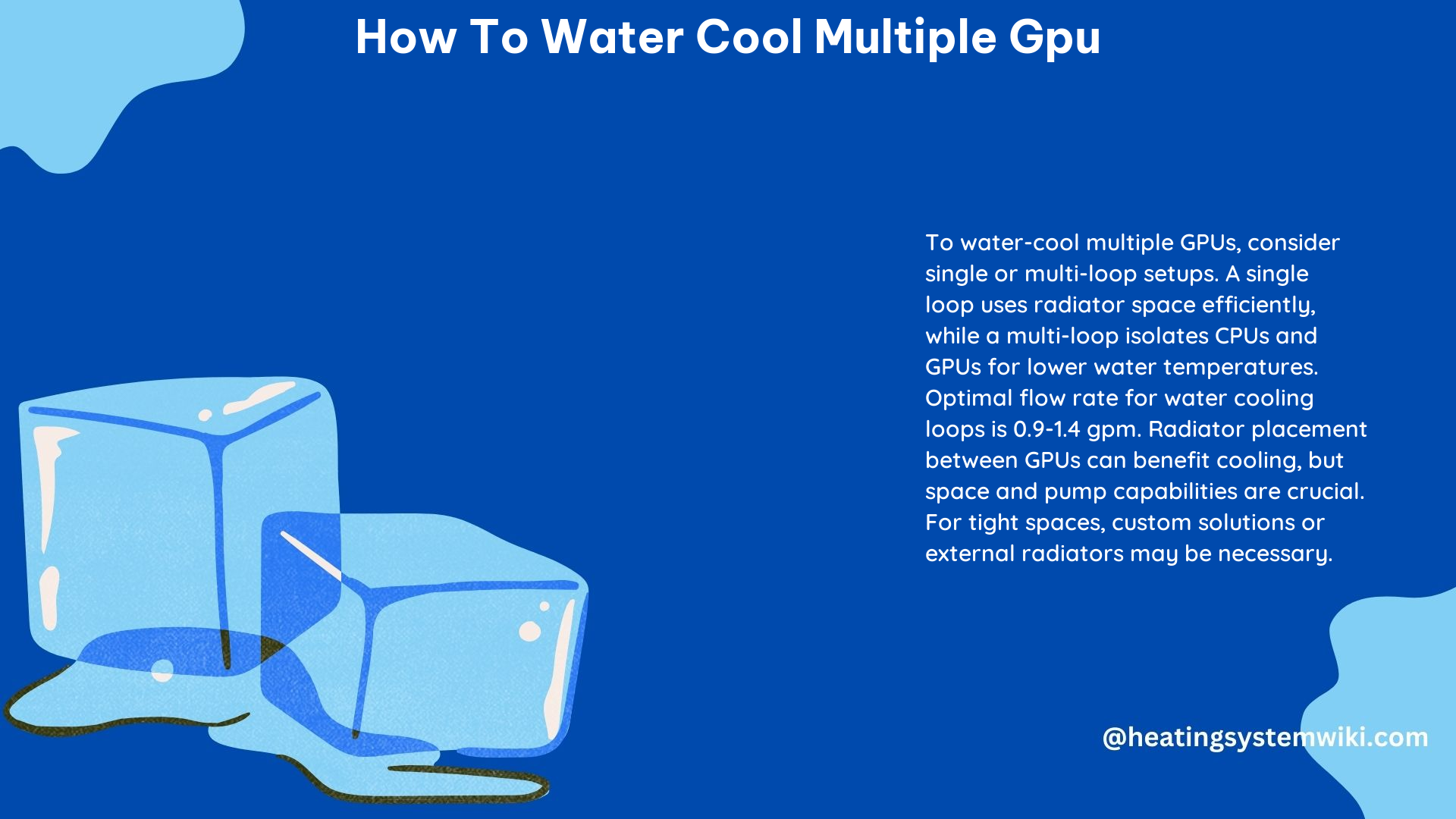Water cooling multiple GPUs can be a complex but rewarding process, offering significant improvements in cooling performance and overclocking potential. This comprehensive guide will delve into the key considerations and best practices to ensure a successful multi-GPU water cooling setup.
Loop Configuration
When water cooling multiple GPUs, you have two primary options for loop configuration: a single loop or a multi-loop setup.
Single Loop Configuration:
– Offers greater efficiency in terms of radiator space and component utilization, as all heat is dissipated through a single loop.
– Provides a more streamlined and compact setup.
– Requires careful planning to maintain consistent flow rates and temperatures across all components.
Multi-Loop Configuration:
– Allows you to isolate the CPU and GPU loops, enabling you to run them at different temperatures.
– Provides more flexibility in terms of component placement and loop optimization.
– Requires additional hardware, such as a second pump and radiator, which can increase complexity and cost.
The choice between a single or multi-loop configuration will depend on your specific cooling requirements, system layout, and personal preferences.
Radiator Size and Placement

The size and placement of your radiators can have a significant impact on cooling performance. Larger radiators provide more surface area for heat dissipation, but they also require more space and can be more challenging to install.
Radiator Size Recommendations:
– For a dual-GPU setup, it’s generally recommended to use at least two 360mm radiators, with one dedicated to the GPUs and one for the CPU.
– For a triple-GPU setup, consider using three 360mm radiators or two 480mm radiators.
– The total radiator surface area should be proportional to the total heat output of your system, with a general rule of thumb being 120mm of radiator per component (CPU or GPU).
Radiator Placement:
– Position the radiators in a push-pull configuration, with fans on both sides of the radiator, to improve cooling performance.
– Ensure adequate airflow around the radiators by placing them in well-ventilated areas of your case.
– Consider the overall system layout and cable management when determining the optimal radiator placement.
Water Block Selection
Choosing the right water blocks for your GPUs is crucial for optimal cooling performance. Look for blocks with the following characteristics:
Flow Rate and Restriction:
– High flow rates and low restriction are desirable to maintain consistent flow throughout the loop.
– Typical flow rates for multi-GPU setups range from 0.9 to 1.4 gallons per minute (GPM).
Compatibility:
– Ensure the water blocks are compatible with your specific GPU models and that they are properly installed and torqued to the manufacturer’s specifications.
Design and Construction:
– Opt for water blocks with efficient cooling channel designs and high-quality materials, such as copper or nickel-plated copper.
– Consider the overall aesthetic of the water blocks to match your system’s theme.
Pump Selection and Placement
The pump is responsible for circulating the coolant throughout the loop, so choosing a pump with sufficient flow rate and pressure is crucial.
Pump Recommendations:
– For a multi-GPU setup, it’s generally recommended to use a dual D5 pump configuration or a single high-flow pump, such as the EK-XTOP SPC-60 PWM.
– Dual D5 pumps provide redundancy and can deliver flow rates up to 1.5 GPM, ensuring consistent and reliable coolant circulation.
Pump Placement:
– Position the pump in a central location within the loop to ensure even flow rates throughout the system.
– Avoid placing the pump at the highest point of the loop, as this can increase the risk of cavitation and reduce the pump’s efficiency.
Tubing and Fittings
The choice of tubing and fittings can also impact the overall performance and aesthetics of your water cooling setup.
Tubing Options:
– Soft tubing, such as PVC or PETG, is generally easier to work with and provides more flexibility in routing.
– Hard tubing, like acrylic or PETG, offers a more rigid and visually appealing setup but can be more challenging to install and maintain.
Fitting Considerations:
– Use high-quality, low-restriction fittings to minimize flow restrictions and maintain consistent coolant flow.
– Ensure a tight seal between the tubing and fittings to prevent leaks.
– Consider the overall aesthetic of the fittings to complement the rest of your system’s design.
Maintenance and Cleaning
Regular maintenance and cleaning are essential for maintaining optimal cooling performance and preventing damage to your components.
Maintenance Tasks:
– Regularly check for any signs of leaks or coolant degradation.
– Clean the radiators and water blocks to remove any buildup of dust or debris.
– Replace any worn or damaged components, such as tubing or fittings.
– Monitor coolant levels and top up as needed to maintain proper fluid levels.
Cleaning Recommendations:
– Use a dedicated water cooling system cleaner to thoroughly flush the loop and remove any contaminants.
– Disassemble and clean the water blocks, ensuring all cooling channels are free of debris.
– Inspect the radiators and clean them using a soft-bristle brush or compressed air.
By following these best practices and technical considerations, you can successfully water cool multiple GPUs, achieving improved cooling performance, increased overclocking potential, and a visually stunning system.
